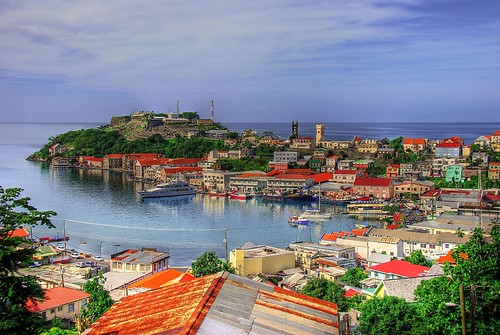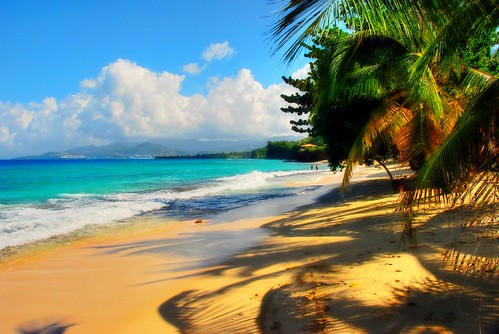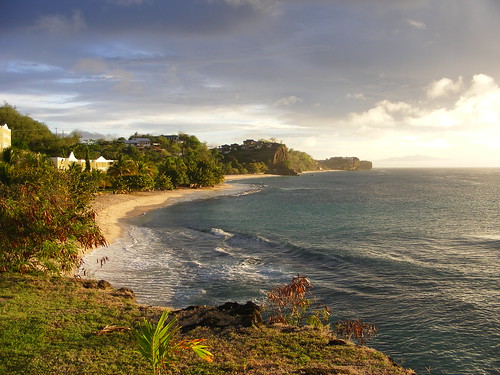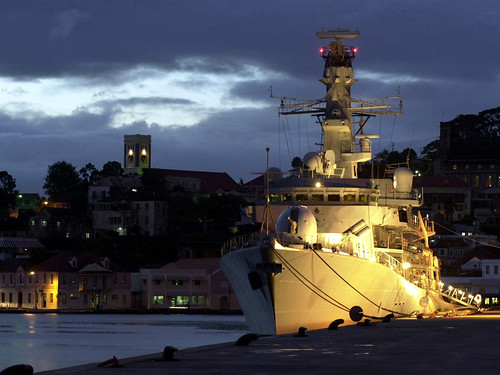Grenada (pronounced /ɡrɪˈneɪdə/) is an island nation and sovereign state consisting of the island of Grenada and six smaller islands at the southern end of the Grenadines in the southeastern Caribbean Sea.
Grenada is located northwest of Trinidad and Tobago, northeast of Venezuela, and southwest of Saint Vincent and the Grenadines. Its size is 344 km² with an estimated population of 110,000. Its capital is St. George's. The national bird of Grenada is the critically endangered Grenada Dove.
Grenada is located northwest of Trinidad and Tobago, northeast of Venezuela, and southwest of Saint Vincent and the Grenadines. Its size is 344 km² with an estimated population of 110,000. Its capital is St. George's. The national bird of Grenada is the critically endangered Grenada Dove.
The island Grenada itself is the largest island; smaller Grenadines are Carriacou, Petit Martinique, Ronde Island, Caille Island, Diamond Island, Large Island, Saline Island and Frigate Island. Most of the population lives on Grenada itself, and major towns there include the capital, St. George’s, Grenville and Gouyave. The largest settlement on the other islands is Hillsborough on Carriacou.
The islands are of volcanic origin with extremely rich soil. Grenada’s interior is very mountainous with Mount St. Catherine being the highest at 2,756 feet (840 m). Several small rivers with beautiful waterfalls flow into the sea from these mountains. The climate is tropical: hot and humid in the rainy season and cooled by the trade winds in the dry season.
Grenada, being on the Southern edge of the hurricane belt, has suffered only three hurricanes in fifty years. Hurricane Janet passed over Grenada on 23 September 1955 with winds of 115 mph, causing severe damage. The most recent storms to hit have been Hurricane Ivan on September 7, 2004 causing severe damage and thirty-nine deaths and Hurricane Emily on July 14, 2005, causing serious damage in Carriacou and in the north of Grenada which had been relatively lightly affected by Hurricane Ivan.
Grenada, being on the Southern edge of the hurricane belt, has suffered only three hurricanes in fifty years. Hurricane Janet passed over Grenada on 23 September 1955 with winds of 115 mph, causing severe damage. The most recent storms to hit have been Hurricane Ivan on September 7, 2004 causing severe damage and thirty-nine deaths and Hurricane Emily on July 14, 2005, causing serious damage in Carriacou and in the north of Grenada which had been relatively lightly affected by Hurricane Ivan.
Grenada, like many of the Caribbean islands is subject to a large amount of migration, with a large number of young people wanting to leave the island to seek life elsewhere. With just 110,000 people living in Grenada, estimates and census data suggest that there are at least that number of Grenadian-born people in other parts of the Caribbean (such as Barbados and Trinidad) and at least that number again in First World countries.
Popular migration points for Grenadians further north include New York City, Toronto, the United Kingdom (London and Yorkshire predominantly — see Grenadians in the UK) and sometimes Montreal, or as far south as Australia. This means that probably around a third of those born in Grenada still live there.
Popular migration points for Grenadians further north include New York City, Toronto, the United Kingdom (London and Yorkshire predominantly — see Grenadians in the UK) and sometimes Montreal, or as far south as Australia. This means that probably around a third of those born in Grenada still live there.
The official language, English, is used in the government, but Grenadian Creole is considered the lingua franca of the island. French Patois (Antillean Creole) is still spoken by about 10%–20% the population. Some Hindi/Bhojpuri terms are still spoken amongst the Indian descendants, mostly those pertaining to the kitchen; such as aloo, geera, karela, seim, chownkay, and baylay.
The term bhai, which means 'brother' or 'partner' in Hindi, is a common form of greeting amongst Indo-Grenadians males of equal status. Aside from a marginal community of Rastafarians living in Grenada, nearly all are mainstream Christians[citation needed], about half of them Roman Catholics; Anglicanism is the largest Protestant denomination with Presbyterian and Seventh Day Adventist taking up the remainder. Most Churches have denomination-based schools but are open to all. There is a small Muslim population mostly from Gujarati Indian immigrants who came many years ago and set up some merchant shops.
The term bhai, which means 'brother' or 'partner' in Hindi, is a common form of greeting amongst Indo-Grenadians males of equal status. Aside from a marginal community of Rastafarians living in Grenada, nearly all are mainstream Christians[citation needed], about half of them Roman Catholics; Anglicanism is the largest Protestant denomination with Presbyterian and Seventh Day Adventist taking up the remainder. Most Churches have denomination-based schools but are open to all. There is a small Muslim population mostly from Gujarati Indian immigrants who came many years ago and set up some merchant shops.
Tourism is Grenada’s main economic force. Conventional beach and water-sports tourism is largely focused in the southwest region around St Georges, the airport and the coastal strip; however, ecotourism is growing in significance. Most of these small ecofriendly guesthouses are located in the Saint David and Saint John parishes.
You will find a lot of different accommodations from luxury like the Spice Island Beach Resort to small cottages resorts like Mango Bay Cottages.The tourism industry is increasing dramatically with the construction of a large cruise ship pier and esplanade. Up to 4 cruise ships per day were visiting St. Georges in 2007–8 during the cruise ship season.
Tourism is concentrated in the southwest of the island, around St. Georges, Grand Anse, Lance Aux Epines, and Point Salines. Grenada has many idyllic beaches around its coastline including the 3 km long Grand Anse Beach in St George's which is considered to be one of the finest beaches in the world, and often appears in countdowns of the world's top 10 beaches.
Grenada is linked to the world through the Maurice Bishop International Airport and the St. George’s harbour. International flights connect with other Caribbean islands, the United States, and Europe. There is also a daily fast ferry service between St. George’s and Hillsborough.
You will find a lot of different accommodations from luxury like the Spice Island Beach Resort to small cottages resorts like Mango Bay Cottages.The tourism industry is increasing dramatically with the construction of a large cruise ship pier and esplanade. Up to 4 cruise ships per day were visiting St. Georges in 2007–8 during the cruise ship season.
Tourism is concentrated in the southwest of the island, around St. Georges, Grand Anse, Lance Aux Epines, and Point Salines. Grenada has many idyllic beaches around its coastline including the 3 km long Grand Anse Beach in St George's which is considered to be one of the finest beaches in the world, and often appears in countdowns of the world's top 10 beaches.
Grenada is linked to the world through the Maurice Bishop International Airport and the St. George’s harbour. International flights connect with other Caribbean islands, the United States, and Europe. There is also a daily fast ferry service between St. George’s and Hillsborough.






0 comments:
Post a Comment